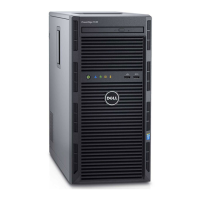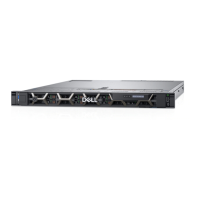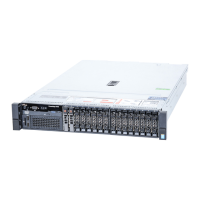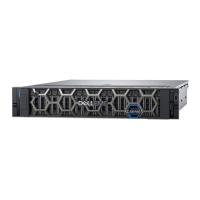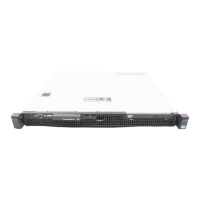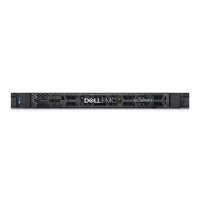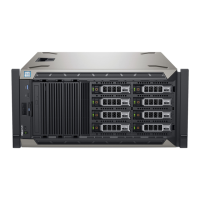Do you have a question about the Dell E30S Series and is the answer not in the manual?
Overview of the supported hardware configurations for the Dell PowerEdge T430 server.
Details on the components and features accessible from the server's front panel.
Details on the components and connectors located on the server's back panel.
Explanation of system indicators that display operational and error status.
Instructions for finding the system's unique service tag for support.
Critical safety precautions required before converting the system from tower to rack mode.
Steps to prepare the server system for conversion to rack mode.
Detailed physical dimensions of the Dell PowerEdge T430 server chassis.
The maximum weight specifications for the Dell PowerEdge T430 server chassis.
Information regarding the supported Intel Xeon processors for the system.
Details on the supported AC power supply units (PSUs) and their ratings.
Information about the CR 2032 3.0-V lithium coin cell system battery.
Details on supported PCI Express (PCIe) generations and slot configurations.
Information on supported DDR4 registered DIMMs (RDIMMs) and their configurations.
Specifications for supported internal hard drives and optical/tape drives.
Details on the system's serial, USB, VGA, NIC, and other ports.
Operating and storage environmental conditions for the system.
Guidelines to avoid equipment damage from environmental contamination.
System's operating temperature limits and restrictions for extended ranges.
A step-by-step guide for the initial setup of the server system.
How to configure network settings for the iDRAC for remote management.
Methods and resources for installing an operating system on the server.
Instructions for obtaining and installing the latest system drivers and firmware.
Overview of applications used for system management before OS boot.
Accessing and using System Setup for BIOS and device configuration.
Embedded capabilities for system deployment, configuration, and maintenance.
Utility for selecting boot devices and launching system utilities.
Using PXE for booting and configuring networked systems remotely.
Critical safety precautions before working with system components.
Preliminary steps required before opening the system or handling components.
Final steps to complete after internal system work and before powering on.
List of essential tools required for component procedures.
Procedures for removing and installing the optional front bezel.
Steps for installing and removing the system feet for tower stability.
Instructions for installing optional caster wheels for system mobility.
Procedures for removing and installing the server's system cover.
Procedures for installing optional optical and tape drives.
Procedures for removing and installing the system's cooling shroud.
Steps for removing and installing hot-swappable hard drive carriers.
Procedures for installing and removing cabled hard drives.
Steps for removing and installing the hard drive backplane.
Procedures for removing and installing four-slot hard drive blanks.
Procedures for installing and removing system memory modules (DIMMs).
Procedures for installing and removing internal and external cooling fans.
Procedures for replacing the optional internal USB memory key.
Procedures for removing and installing the expansion card holder.
Procedures for installing and removing PCIe expansion cards.
Guidelines for installing graphics processing unit (GPU) cards.
Information about the optional iDRAC port card.
Information about the optional internal dual SD module.
Procedures for removing and installing internal SD cards.
Procedures for removing and installing system processors and heat sinks.
Procedures for installing and replacing redundant AC power supply units.
Procedures for removing and installing power supply unit blanks.
Procedures for replacing the power supply unit divider.
Procedures for removing and installing cabled power supply units.
Procedures for removing and installing the power interposer board.
Procedures for replacing the system's CMOS battery.
Procedures for removing and installing the system's control panel assembly.
Procedures for removing and installing the system board (motherboard).
Procedures for installing the Trusted Platform Module (TPM) on the system board.
Procedures for removing and installing the system top cover.
Introduction to the ePSA diagnostics for system hardware testing.
How to initiate system diagnostics from the Boot Manager.
How to initiate system diagnostics using the Dell Lifecycle Controller.
Explanation of the menus and controls within the system diagnostics tool.
Identification and location of connectors on the system board.
Configuration options and functions of system board jumpers.
Procedure to reset system and setup passwords using the jumper.
Steps to resolve issues preventing the system from starting correctly.
Steps to resolve problems with external device connectivity.
Steps to resolve problems related to video output and display.
Steps to diagnose and fix issues with USB devices.
Resolving issues with iDRAC Direct USB XML and laptop connections.
Steps to resolve problems with serial input and output devices.
Steps to diagnose and fix problems with the network interface card.
Procedures for handling and troubleshooting systems affected by liquid or physical damage.
Steps to diagnose and resolve problems related to the system battery.
Procedures for diagnosing and fixing problems with power sources and PSUs.
Steps to diagnose and resolve issues related to system memory modules.
Steps to diagnose and fix problems with optical and tape backup drives.
Steps to diagnose and resolve issues related to hard drives and SSDs.
Steps to diagnose and fix problems with installed expansion cards.
Steps to diagnose and resolve issues related to the system's processors.
Information on how to obtain technical support and service from Dell EMC.
Instructions on how to submit feedback regarding the user manual.
Using Quick Resource Locator (QRL) for system information.
Overview of the supported hardware configurations for the Dell PowerEdge T430 server.
Details on the components and features accessible from the server's front panel.
Details on the components and connectors located on the server's back panel.
Explanation of system indicators that display operational and error status.
Instructions for finding the system's unique service tag for support.
Critical safety precautions required before converting the system from tower to rack mode.
Steps to prepare the server system for conversion to rack mode.
Detailed physical dimensions of the Dell PowerEdge T430 server chassis.
The maximum weight specifications for the Dell PowerEdge T430 server chassis.
Information regarding the supported Intel Xeon processors for the system.
Details on the supported AC power supply units (PSUs) and their ratings.
Information about the CR 2032 3.0-V lithium coin cell system battery.
Details on supported PCI Express (PCIe) generations and slot configurations.
Information on supported DDR4 registered DIMMs (RDIMMs) and their configurations.
Specifications for supported internal hard drives and optical/tape drives.
Details on the system's serial, USB, VGA, NIC, and other ports.
Operating and storage environmental conditions for the system.
Guidelines to avoid equipment damage from environmental contamination.
System's operating temperature limits and restrictions for extended ranges.
A step-by-step guide for the initial setup of the server system.
How to configure network settings for the iDRAC for remote management.
Methods and resources for installing an operating system on the server.
Instructions for obtaining and installing the latest system drivers and firmware.
Overview of applications used for system management before OS boot.
Accessing and using System Setup for BIOS and device configuration.
Embedded capabilities for system deployment, configuration, and maintenance.
Utility for selecting boot devices and launching system utilities.
Using PXE for booting and configuring networked systems remotely.
Critical safety precautions before working with system components.
Preliminary steps required before opening the system or handling components.
Final steps to complete after internal system work and before powering on.
List of essential tools required for component procedures.
Procedures for removing and installing the optional front bezel.
Steps for installing and removing the system feet for tower stability.
Instructions for installing optional caster wheels for system mobility.
Procedures for removing and installing the server's system cover.
Procedures for installing optional optical and tape drives.
Procedures for removing and installing the system's cooling shroud.
Steps for removing and installing hot-swappable hard drive carriers.
Procedures for installing and removing cabled hard drives.
Steps for removing and installing the hard drive backplane.
Procedures for removing and installing four-slot hard drive blanks.
Procedures for installing and removing system memory modules (DIMMs).
Procedures for installing and removing internal and external cooling fans.
Procedures for replacing the optional internal USB memory key.
Procedures for removing and installing the expansion card holder.
Procedures for installing and removing PCIe expansion cards.
Guidelines for installing graphics processing unit (GPU) cards.
Information about the optional iDRAC port card.
Information about the optional internal dual SD module.
Procedures for removing and installing internal SD cards.
Procedures for removing and installing system processors and heat sinks.
Procedures for installing and replacing redundant AC power supply units.
Procedures for removing and installing power supply unit blanks.
Procedures for replacing the power supply unit divider.
Procedures for removing and installing cabled power supply units.
Procedures for removing and installing the power interposer board.
Procedures for replacing the system's CMOS battery.
Procedures for removing and installing the system's control panel assembly.
Procedures for removing and installing the system board (motherboard).
Procedures for installing the Trusted Platform Module (TPM) on the system board.
Procedures for removing and installing the system top cover.
Introduction to the ePSA diagnostics for system hardware testing.
How to initiate system diagnostics from the Boot Manager.
How to initiate system diagnostics using the Dell Lifecycle Controller.
Explanation of the menus and controls within the system diagnostics tool.
Identification and location of connectors on the system board.
Configuration options and functions of system board jumpers.
Procedure to reset system and setup passwords using the jumper.
Steps to resolve issues preventing the system from starting correctly.
Steps to resolve problems with external device connectivity.
Steps to resolve problems related to video output and display.
Steps to diagnose and fix issues with USB devices.
Resolving issues with iDRAC Direct USB XML and laptop connections.
Steps to resolve problems with serial input and output devices.
Steps to diagnose and fix problems with the network interface card.
Procedures for handling and troubleshooting systems affected by liquid or physical damage.
Steps to diagnose and resolve problems related to the system battery.
Procedures for diagnosing and fixing problems with power sources and PSUs.
Steps to diagnose and resolve issues related to system memory modules.
Steps to diagnose and fix problems with optical and tape backup drives.
Steps to diagnose and resolve issues related to hard drives and SSDs.
Steps to diagnose and fix problems with installed expansion cards.
Steps to diagnose and resolve issues related to the system's processors.
Information on how to obtain technical support and service from Dell EMC.
Instructions on how to submit feedback regarding the user manual.
Using Quick Resource Locator (QRL) for system information.




